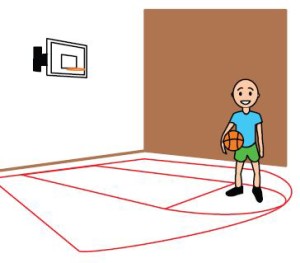 The challenges that autism presents in a busy social environment can be difficult for anyone to support. The number of possible triggers in a place that is full of moving people, changing social rules, and loud noises can cause one on the spectrum to escalate easily. Pair that with an educator whose attention is being shared between twenty or more students in motion and you can begin to see why P.E. is often unsuccessful for students with autism. While having the student just not participate can be an easy solution, it does little to help the learner raise their game. Here are some tips to help maximize your student’s time in the gym.
The challenges that autism presents in a busy social environment can be difficult for anyone to support. The number of possible triggers in a place that is full of moving people, changing social rules, and loud noises can cause one on the spectrum to escalate easily. Pair that with an educator whose attention is being shared between twenty or more students in motion and you can begin to see why P.E. is often unsuccessful for students with autism. While having the student just not participate can be an easy solution, it does little to help the learner raise their game. Here are some tips to help maximize your student’s time in the gym.
- Know the challenger. Autism is complex. Ensure that everyone on the team, including the P.E. teacher, knows the basics of autism and how it effects the given student(s). This will help give a stronger filter when deciding which supports to implement.
- Help with preparation. As often as possible, before introducing something new to the class make sure your student with autism has practiced it prior, whether it be one on one, at home, or in another class. Having already had success with at least some of the work can go a long way in easing anxiety.
- Share the game plan. Whether it be on the whiteboard, on a note card, or just verbally sharing in advance, ensure your learner knows what the schedule is. Minimizing the unexpected can help immensely in reducing large behavioral reactions. Know your learner and know which method is going to be the most meaningful for them. The more the learner can take ownership of the schedule, the better.
- Warm up the mind with the body. Just like you would never start out with sprints, you also would not want to start with something the learner has never done. Begin with what is common and comfortable. Some kids may need you to go so far as to have them do the same exact warm up every day, even if it is different from what the rest of the class is doing.
- Clarify boundaries. The red line may mean the starting line today, but tomorrow it may represent the out of bounds line, and the day after that it may represent a line to be jumped over. The landscape of this classroom is constantly changing and this can be very disorienting for learners on the spectrum. Specify clearly at the beginning of each activity what lines and markers mean what and check for understanding.
- Team up. Pairing your student with an appropriate peer can be a good way to provide a frequent model for desired behavior. It can also help foster more positive relationships with others in the class. Just be sure to give the peer a quick heads up on how they can be a helpful partner.
- Be flexible. There may be some activities that your student is naturally terrified of, such as volleyball. In such cases, give permission to not have them participate in the traditional sense. Give them a job in a supportive role such as ball boy or have a backup activity ready such as individualized circuit training.
- Remember half time. There will be some students who will not have the capacity to hold it together for the entire class. Make victory possible by providing them a scheduled break midway through. While the bench is always an easy go-to, the learner may need to leave the gym and return a few minutes later to be fully equipped to re-engage.
- Use this time to practice. If your student struggles behaviorally or socially during P.E., it is likely not the only place in the schoolhouse where this happens. Make sure that the student’s team is connecting so that everyone knows the strategies being used to support de-escalation and socialization. P.E. is not the class in which strategies should be introduced for the first time, but it certainly can be a place where they are practiced.
- Raise the roof!!!! Remember to celebrate your student(s) in all of their success both great and small. Cheer them on as they brave the challenges that P.E. throws at them, and take joy in their small achievements. This can help increase their confidence as learners while also increasing your confidence as an educator. When you take the time to raise the roof for a child with autism, you can help increase the ceiling at which they perform.






This is awesome! It confirms some thing we are already doing and offers a approach to what we can be better at. Thank you for sharing!!